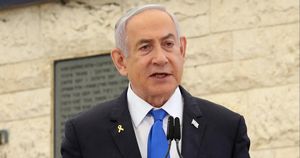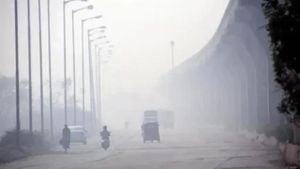Hezbollah's chief spokesman, Mohammed Afif, was killed during a rare Israeli airstrike in central Beirut on Sunday, marking another deadly escalation in the conflict between Israel and Hezbollah. The airstrike, which also resulted in civilian casualties, occurred as Israeli forces continue to target Hezbollah positions amid the broader conflict with Hamas.
Witnesses at the scene reported chaos and devastation. Suheil Halabi, who experienced the strike firsthand, described the unsettling moment, saying, "I was asleep and awoke from the sound of the strike, and people screaming, and cars and gunfire. I was startled, honestly. This is the first time I experience it so close."
The end of Afif's life is significant not only for his role as Hezbollah's media relations chief but also as he was believed to be part of the inner circle of the group's late leader, Hassan Nasrallah, who himself was targeted by Israeli airstrikes earlier this year. Throughout the conflict, Afif had been particularly visible, making media appearances as tensions escalated, especially following the outbreak of war between Israel and Hamas.
Eyewitness accounts indicated confusion following the bombing, adding to the tension already felt from high-stakes conflicts raging across Lebanon as Israeli air forces conducted airstrikes aimed at what they claim are Hezbollah strongholds.
The Israeli Defense Forces have not commented on the specific incident leading to Afif’s death. Still, they confirmed operations against Hezbollah, which has been actively engaging Israeli territories since the beginning of hostilities.
Hezbollah has been launching retaliatory strikes against Israel since Hamas's attack on October 7, 2023, igniting increased conflict across the region. They have extended their capability to fire up to 70 rockets daily across various Israeli cities, threatening urban centers including Haifa, which was bombarded recently.
Earlier this month, Israeli airstrikes escalated across various parts of the Lebanese capital, targeting locations deemed as Hezbollah headquarters, particularly areas heavily populated by civilians. On November 17, at least four people were reported dead from the strikes, though the total remains unverified. The latest casualties reflect the severe toll of the almost year-long conflict.
Hezbollah's response and survival tactics have accordingly shifted, with increased military coordination to strike back against Israeli air assaults, leading to significant loss of life and displacement within Lebanon. More than 3,400 people, including numerous Hezbollah militants, have perished as violence persists.
Meanwhile, the humanitarian situation remains dire for countless Lebanese, with over 1.2 million locals displaced amid the continuous military operations. Reports confirm extensive infrastructural damage with many homes destroyed or rendered uninhabitable.
Parallel to these movements, Israeli police took action against domestic dissent, arresting three suspects after flares were launched toward Prime Minister Benjamin Netanyahu's residence overnight. While Netanyahu's family was absent during the incident, it drew reaction from officials concerned about rising violence against public figures.
Israeli officials are carefully hearing the sentiments of the public as protests against the government grow, criticizing the management of the security crisis stemming from the recent waves of violence. These events feed back to political ramifications as regional powers recalibrate their operations and narratives surrounding the various conflicts.
Hezbollah's military capability has increasingly tied to their ability to relay information effectively through spokespersons like Afif. Following the loss of its senior figure, Hezbollah will face challenges maintaining its propaganda machine and cohesive messaging as the conflict with Israel continues to escalate.
The current conflict, marked by aggressive Israeli military strategies targeting both strategic and civilian sites, reflects the broader instability found within the region, and both local and international stakeholders are keeping their eyes on developments as tensions reveal little sign of abatement. The localization of these airstrikes will undoubtedly frame the Hezbollah narrative moving forward and impact the Lebanese public's view.
Though the situation remains fluid, narratives surrounding increased civilian suffering amid military operations continue to dominate the discourse.
Hezbollah's leadership faces pressure following Afif's death and Israel’s relentless military response. While Hezbollah has pledged retaliation, the combat's future dynamics may shift significantly, potentially leading to higher losses amid already established hostilities.
Politically, this targeted strike not only serves to eliminate key Hezbollah figures but also enables Israel to exert pressure on its foe as U.S.-led discussions of ceasefire proposals continue to surface. A full-scale ceasefire, still under discussion, seems tenuous at best as both sides gear up for continued confrontations.
Given the disproportionate toll exacted on the Lebanese population, immediate humanitarian efforts may need to be implemented to assist aftermath and recovery from the surge of violence, radicalized by competing narratives from both Hezbollah and Israel.
The current instability within Lebanon and the surrounding Middle East remains palpable, with uncertainties looming large. The failed attempts at brokering peace highlight the urgent need for dialogue, as military actions threaten to entrench divisions and amplify civilian suffering.
The events of Sunday represent continued volatility, posing complex questions of governance, military engagement, and civil rights for those caught in the crossfire. While diplomatic efforts may appear stagnant, they remain pivotal for any possible resolution to avoid complete collapse amid the deteriorative humanitarian situation.
Undoubtedly, as artillery fire persists, so too does the need for serious dialogue to grapple with longstanding grievances and build toward sustainable solutions where voices from all sides can be present.



